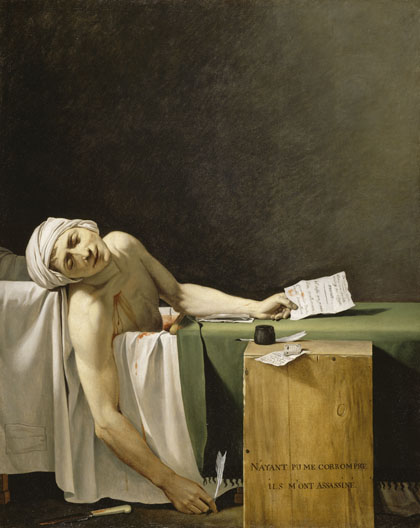Fr : version française / En: english version
mheu, Historical Museum of the Urban Environment
The Death of Marat
Jacques-Louis David (studio of)

1793
130cm x 162cm
oil on canvas
Musée du Louvre, Paris
© RMN / Gérard Blot / Christian Jean
View this work in the exhibition Bathing
The work
This painting, The Death of Marat, was finished in October 1793, just three months after the murder. Several versions and a number of copies exist. One version, said to be the penultimate one, was only recently discovered and sold in Paris in September 2008. The final version is supposed to be the one in the Musées Royaux des Beaux Arts in Brussels, which would make the version in the Louvre the antepenultimate one. Here we notice the painter's great talent for portraiture and the incomparable subtlety of his rendering of light—qualities that are less obvious in his large-scale historical scenes. The most noticeable aspect is the strange light coming from the left and shining on the dark wall like a theater spotlight. It illuminates the body and casts admirable shadows on the skin, highlighting the letter that Marat still holds in his hand as well as the wooden box used as a table for the inkwell and on the side of which is written: "A Marat, David" in the Brussels version and "N'ayant pu me corrompre ils m'ont assassiné" (Unable to corrupt me, they murdered me) in the Paris version.
The artist
Jacques-Louis David, born in Paris in 1748, is considered the great representative of the Neoclassical school, which lauded the esthetic canons of Antiquity and perfection of execution. At sixteen he entered the studio of the Rococo painter Joseph-Marie Vien at the Académie Royale. He narrowly failed three times to win the Prix de Rome (after the third attempt, in 1773, he tried to kill himself), before winning it in 1774. He remained in Rome until 1780, returned to exhibit at the Salon du Palais du Louvre in Paris and was elected to the Académie Royale. During the Revolution (he was one of its most fervent agitators before himself being imprisoned after the fall of Robespierre), he developed a particular style based on Roman classical art. His work took on a patriotic and moralistic tone. In 1797, he met Napoleon, then General Bonaparte (who was to appoint him First Painter to the Empire in 1804) and was to remain loyal to him until the debacle of Waterloo, which caused him to be exiled from the kingdom by Louis XVIII, in 1816. He found refuge in Brussels where he painted a series of portraits of prominent Belgian figures. Despite being granted amnesty, he refused to return to France and died in the Belgian capital in 1825.